How to Increase Your Payback from Using LinkedIn
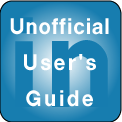 LinkedIn is a “social” site that will prove to be of rare benefit to business executives and professionals in building individualized collaborative networks, as I explained in detail in the GHCJ Review of LinkedIn. However, LinkedIn is seriously lacking in providing a step-by-step guide to help the motivated executive to tap its real value. The functionality of the website is easy to use, but many of the finer points of LinkedIn are lost on the majority of users. This guide attempts to address that.
LinkedIn is a “social” site that will prove to be of rare benefit to business executives and professionals in building individualized collaborative networks, as I explained in detail in the GHCJ Review of LinkedIn. However, LinkedIn is seriously lacking in providing a step-by-step guide to help the motivated executive to tap its real value. The functionality of the website is easy to use, but many of the finer points of LinkedIn are lost on the majority of users. This guide attempts to address that.
The “Unofficial User’s Guide” is divided into two parts: The Basics and Advanced Techniques. If you are at the point of deciding whether LinkedIn could be useful to you, I urge you to read the Review of LinkedIn first. This guide is a hack and makes no claim to be extensively studied or ultimately comprehensive, but I have striven to make it immediately useful. I will undoubtedly update it, as I become aware of additional features and techniques.
My motivation for writing it is to increase understanding of LinkedIn’s incredible potential and to hasten adoption among senior executives and professionals. (For an update on motivations, please see comments below).
 The User’s Guide aims to help to people in these circumstances:
The User’s Guide aims to help to people in these circumstances:
- Casual Member—have a small network, but don’t see much value; maybe check the LinkedIn site once a month.
- Active Member—have used LinkedIn extensively but are always looking to get more value out of it.
- Know of LinkedIn but not a Member—Have heard about it but haven’t joined due to privacy or other concerns; curious about how/why others are using it.
- Just heard of Linkedin—interested in how and why others are using it and why you might want to use it.
- Curious about social networks—learn interested in social network phenomena and how networks work.
The Basics
Glossary of Key LinkedIn Terms
The Different Network Levels and How They Work
There are four “views” relevant to LinkedIn, which I’ve arranged here in the order of most visibility (from using LinkedIn) to least:
- Your network, including 1st, 2nd and 3rd degree (this is the violet circle with the blue, green and orange contacts).
- The LinkedIn network (this is the gray circle with the gold contacts).
- The non-LinkedIn network (Google, the Internet); not shown.
- The non-networked network/not on the Internet (the least visibility); not shown.
Your Network
 You can directly communicate with people who are connections (“1st degree”), but you can see certain information about people who are in your network’s network (“2nd degree”) and your network’s network’s network (“3rd degree”). For example:
You can directly communicate with people who are connections (“1st degree”), but you can see certain information about people who are in your network’s network (“2nd degree”) and your network’s network’s network (“3rd degree”). For example:
- Your 1st degree contacts are your Connections—in LinkedIn terms, your strongest ties.
- When you want to communicate with a person connected to one of your connections (2nd degree, to you), you must request an introduction from your 1st degree person, who forwards your communication (s/he is the “Forwarder”). If Barbara is the 2nd degree person I want to reach, and I’m connected to her through Boris, I write Barbara a note stating why I’d like to connect with her and a note to Boris in which I request an introduction to Barbara. Boris reads both and can choose to forward my note to Barbara or not.
- The same process, with another link, accesses 3rd degree people. Here, I write a note to Robert (3rd degree) stating why I’d like to connect with him as well as an introduction request to Boris (1st), and Boris writes a note to the 2nd degree person (Cathy) whom he and Robert have in common. Cathy then views the notes and passes my note to Robert (or not). In this case, I can’t see Cathy because I don’t know her (she’s in Boris’s network, not mine). She will often write a short cover note as well.
- Note that several people see your communications and requests, so take this into account when writing them. Scott Allen’s Linked Intelligence is loaded with helpful examples (see “Other LinkedIn Resources” below).
The strength of the network is trust. Someone you know is more responsive to your requests. Also, if you help others, they tend to reciprocate (just like in the non LinkedIn world! ,^). Here are the numbers of my network, as of writing:
- 1st degree: 146 – 2nd degree: 24,900 – 3rd degree: 1,489,400
- That means I can communicate with more than 1,514,500 people, out of the 9,000,000 LinkedIn members.
The LinkedIn Network
Outside your 3rd degree network is the LinkedIn network, but you can only see it or communicate with it if you upgrade your membership. For example, as a Business member, my searches return results from my network and from the LinkedIn network that most closely match my request (say, “French, biotech, cycling”). “Personal” (free) members only see results from their networks.
Since the French speaking cyclist is not in my network, I only see a basic description of his/her title and company type but no name or contact info. As a “Business” member, however, I can send three “InMails” per month, thereby contacting up to three people from the LinkedIn network to whom I’m not connected. InMails go directly from me to someone I don’t know. So, I can send the cyclist an InMail and, if s/he responds, we can communicate. As an additional step, we could decide to connect (that would be a 1st degree connection).When s/he receives the InMail, s/he can refuse it, block me from ever contacting him/her again or respond, after which we can communicate. This is an important safeguard against unwanted “connecters.”
Non-LinkedIn Networks
You can invite people who are not members to join LinkedIn. As with all network phenomena, the “network effect” is very meaningful here: the value of the network increases the more people that are part of it. Given that older generation leaders are more hesitant to step into digital social networks, it is especially crucial to have them represented.
Membership Types and Fees
You can build a very robust network using the free “Personal” LinkedIn membership. However, you may want to explore paid memberships, especially if you do not have a large group of trusted contacts to import or you want to expand your contacts into a different area. Here are the different memberships, side by side. If you want a close-up, click the graphic to open a pdf that you can expand as needed.
Creating Your Network
Join LinkedIn in One of Two Ways
- Go to www.linkedin.com, create a profile, and start inviting people to be your connections (1st degree)—or respond to an invitation of a LinkedIn member, create a profile, and start inviting people to be connections.
- If you choose the first route, you will have a profile but no “connections.” With the second way, you will have one connection, the member who invited you.
- In order to invite people to be connections, you need to reach them via email after hitting the “Know this person? Add them as a connection” link.
 The Cornerstone of Your Network: Initial Thoughts on Building Community
The Cornerstone of Your Network: Initial Thoughts on Building Community
- If you take nothing else away from the User’s Guide, remember the importance of choosing your connections carefully. For simplicity, let’s say that there are two key strategies to building your community: high numbers with loose ties and lower numbers with strong ties. More on each of these under Advanced Strategies below. Neither is “best” for everyone, but it will help you to know the advantages of each.
- Be aware that your network is a community that you are building, so try to have a vision for it as you start. Build with purpose.
- For example, inviting ten people that you have known for years and who have similar interests to yours might be a good start for a strong ties strategy. True, you would have less reach at first, but each connection might be more responsive in terms of forwarding introductions and proactively helping you with an initiative to find a job, an angel or a key employee.
- When one of your connections asks you to forward an introduction, make it a priority. Show that you take it seriously, and they will tend to reciprocate. Look at it this way, you won’t save time by delaying 😉 The way that you interact with your network is a strong factor in creating the culture of your community. You get out of it what you put into it.
- Spend some time browsing through LinkedIn Answers. Try to imagine whether you might find such a feature useful. If you like the idea of having your connections be a personal advisory board, that might be a guiding principle for choosing a strong ties strategy.
- On the other hand, if your goals are less defined and require connecting with younger, emergent professionals in many fields, a loose ties strategy might be more appropriate because you can cast a wide net and leave more to serendipity.
- Try to envision what your network/community will look like a year cot two from now: what are your goals, who will be in your network, and what will be the nature of your interactions? What will be most natural for them?
Models for Using LinkedIn to Maximize Return on Investment
Trust is the glue that holds LinkedIn together. In general, it is not advisable to invite too many people to be connections whom you would not feel comfortable recommending or referring to someone else (and staking your reputation on the recommendation). Connections are people in your “1st degree” network, and they should be trusted connections with whom you have reciprocal relationships to actively help each other. Members can connect with other trusted members according to specific rules.
There are many ways that you can use LinkedIn, but you can use these four models to think about how you want to invest in LinkedIn and what you want to get out of it. They are arranged from lowest to highest level of activity. In general, the models collapse into each other: Network Management includes Professional Presence, and Network Building includes both models that precede it.
Professional Presence
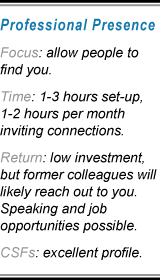 Whether you are a scientist, an account executive, an architect or a CIO, chances are there are people you have worked or studied with in the past with whom you’ve lost touch. You might be open to speaking at conferences or to entertaining qualified contacts by executive recruiters. By creating a profile, you can enable people to find you and to get back in touch. Unless someone is one of your connections, they cannot contact you unless they request an Introduction from one of your trusted contacts. They cannot contact you directly unless they are a paid user who “spends” a valuable InMail, which you can refuse if you do not appreciate the contact. You can also block someone from contacting you ever again.
Whether you are a scientist, an account executive, an architect or a CIO, chances are there are people you have worked or studied with in the past with whom you’ve lost touch. You might be open to speaking at conferences or to entertaining qualified contacts by executive recruiters. By creating a profile, you can enable people to find you and to get back in touch. Unless someone is one of your connections, they cannot contact you unless they request an Introduction from one of your trusted contacts. They cannot contact you directly unless they are a paid user who “spends” a valuable InMail, which you can refuse if you do not appreciate the contact. You can also block someone from contacting you ever again.
- Focus—Select account settings and build your profile; perhaps you search LinkedIn for people you know who are already members and invite them to connect.
- Time required—settings and profile (1-3 hours, depending on the length of your background and whether you have current bios and/or resumes). 1-2 hours per month inviting people you know to connect with you on LinkedIn. This is secondary to creating your presence.
- Return on investment—You have spent a couple of hours to create a profile that will enable opportunities to find you.
- Critical Success Factors—The quality profile (specific facts) is key in attracting opportunities. See the Guy Kawasaki LinkedIn profile makeover below for specific advice.
By describing your professional interests and talents in detail and using specific search terms, you enable opportunities to come to you, and you can easily help your friends and acquaintances find better situations or clients. Basically, this involves filling out the basic outline of your professional information. The advantages to doing this on LinkedIn rather than a job or resume site are several: LinkedIn is not a job site, so your current employer will not assume that you are looking for another job if s/he sees your profile; your contact information is not disclosed unless you go out of your way to include it in your public profile, so you cannot be spammed; your name is only disclosed to people in your network; all kinds of opportunities can present themselves, like speaking engagements, new clients, etc.
Network Management
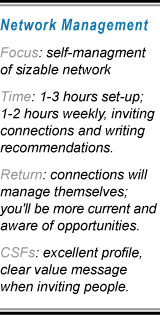 Unlike “Professional Presence,” the focus here is on inviting people you already know to connect on LinkedIn, so you all can use its automated features to keep in touch better. You probably have a sizable network of people you’ve met from several jobs, engagements, schools and/or professional groups, and you know it is a struggle to keep track of everyone’s contact information. By connecting with people on LinkedIn, you stay connected, even as everyone is bouncing around in different jobs or countries. Or even if someone changes her name!
Unlike “Professional Presence,” the focus here is on inviting people you already know to connect on LinkedIn, so you all can use its automated features to keep in touch better. You probably have a sizable network of people you’ve met from several jobs, engagements, schools and/or professional groups, and you know it is a struggle to keep track of everyone’s contact information. By connecting with people on LinkedIn, you stay connected, even as everyone is bouncing around in different jobs or countries. Or even if someone changes her name!
- Focus—import contacts from your address book, and search LinkedIn for your contacts who are already members and invite to connect; invite your contacts who are not members to evaluate it, become members and connect with you. Keep in mind that the response rate will be higher from people who are already members of LinkedIn than nonmembers, who must first decide whether they want to be members before they can connect with you. Refer them to the Unofficial User’s Guide!
- Time investment—settings and profile (1-3 hours, depending on the length of your background and whether you have current bios and/or resumes); building your connections list and writing recommendations can be done weekly for 2-4 hours per week.
- Return on Investment—on average, you will have high upfront time investment but low maintenance (time) cost. You can minimize this by using LinkedIn’s import feature and the Contacts List. In return, you will always be more in touch with your circle of contacts, especially if you enable LinkedIn to notify you when your connections change their profiles, and opportunities of many types will likely surface over time. You will not lose contact with them, nor they with you. If you import and park contacts in “Other Contacts” (see Glossary, above), LinkedIn will not do anything with them or retain them.
- Critical Success Factors—here you will build a sizable network by transferring your existing contacts to LinkedIn, so think through your strategy (i.e. strong, weak ties). Be consistent, and experiment with processes for inviting people. Before you invite someone, ask yourself how you would refer the person to someone else. By having him/her as a connection, the assumption is that you can recommend at least one key facet of the person and his/her knowledge and value.
- Was s/he a vendor you had a conversation with once at a trade show? Avoid that kind of connection because you don’t know the person well enough to refer him/her. Other people are going to ask you about your connections. You don’t have to know them extremely well, only well enough to recommend them. This is the bulwark of LinkedIn’s culture of trust.
- Recommendations are a way to indicate stronger bonds within your group of connections because you describe an element of your relationship with the person and how s/he added value to you. Recommendations are very underutilized. See links below on writing great ones.
My own non-LinkedIn global network numbers in the thousands, so keeping up with friends and acquaintances is daunting. Today, when I call or email someone, and their information is outdated, I am grateful to LinkedIn when I find the person and can reconnect without emailing around to find them. From my perspective, LinkedIn enables the people in my network to “service themselves” to the benefit of me and others who want to contact them. In a sense, it’s like a global “phone book” of professionals and executives.
Network Building
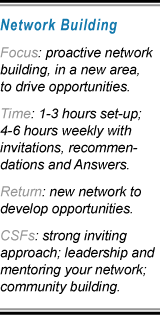 As its name suggests, this model emphasizes using LinkedIn to expand your contacts into new areas. You can search the LinkedIn network for anything, and people you will find are usually high quality. If you are a deal maker, an entrepreneur or a business development executive, you can use LinkedIn to actively create connections in areas in which you are developing ventures or deals. LinkedIn can drastically reduce the time it takes to find someone by using specific search terms. Since others are also trying to find people, that suggests how important it is to create your profile with care. Use specific phrases and words in your profile and when you search for people.
As its name suggests, this model emphasizes using LinkedIn to expand your contacts into new areas. You can search the LinkedIn network for anything, and people you will find are usually high quality. If you are a deal maker, an entrepreneur or a business development executive, you can use LinkedIn to actively create connections in areas in which you are developing ventures or deals. LinkedIn can drastically reduce the time it takes to find someone by using specific search terms. Since others are also trying to find people, that suggests how important it is to create your profile with care. Use specific phrases and words in your profile and when you search for people.
- Focus—search LinkedIn for new contacts who are already members as well as non-LinkedIn people, and invite to connect. Write recommendations for people, and experiment with LinkedIn Answers. Consider becoming an expert on Answers. Research people you want to meet, and write InMails and introduction requests (of your connections).
- Time Investment—settings and profile (1-3 hours); building your connections list and writing recommendations can be done weekly for 4-6 hours per week.
- Return on Investment—you are investing significant time building a network, but it will be yours forever, independent of employer or school (yours and others). You are also learning how to build a network proactively, a valuable skill that will repeatedly earn dividends. Opportunities will tend to surface in the emerging area in which you’re actively building, although it may take time to build a pipeline.
- Critical Success Factors—the theme here is reaching out to people, so experiment with different processes for approaching people, and document as needed; try various methods for writing InMails and introductions requests, and repeat what works best. In addition, since you are connecting to people you don’t know in the off-line world, devote some time engaging them in discussions online, for example, through LinkedIn Answers. Relevant interactions will strengthen your ties and make your network stronger and more valuable for all members.
LinkedIn enables members to build their networks proactively, and here its social network character shines. In the non-LinkedIn world, it would be difficult for me to find French-speaking biotech professionals who love cycling. You can search the LinkedIn network for people who have specific knowledge or contacts, whether for a new client, contract or job. You can find and talk with specialists globally; it’s as easy as sending an InMail. Botanists in Borneo, direct marketers in China or accountants in Hungary. Because you can search by expertise, language, school, company or anything you can think of, you can be very proactive with reaching out.
Experiment with LinkedIn Answers and other emerging features. You can query your network about specific things (think of it as a forum in which people offer advice, which is seen and commented on by other people). You can write recommendations (think of these as short “references”) and ask others to write them for you (see tips below). Recommendations serve to reduce transaction costs because they impart confidence. Having recommendations that are directly relevant to what you’re trying to do is most valuable.
Network Living
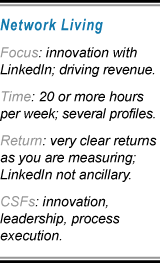 Network living is the highest degree of involvement. Here, creating and managing your professional network is one of the primary parts of your professional activity, and LinkedIn becomes indispensable to you. Recruiters love LinkedIn because it diminishes transaction costs; it has a visible impact on their productivity: the more transactions you do, the more LinkedIn increases your competitiveness. Therefore, think of Network Living as similar to Network Building, except to a greater degree.
Network living is the highest degree of involvement. Here, creating and managing your professional network is one of the primary parts of your professional activity, and LinkedIn becomes indispensable to you. Recruiters love LinkedIn because it diminishes transaction costs; it has a visible impact on their productivity: the more transactions you do, the more LinkedIn increases your competitiveness. Therefore, think of Network Living as similar to Network Building, except to a greater degree.
- Focus—your LinkedIn network has direct bearing on driving revenue, so you are constantly reaching out to the people who will help you in your business. You may collaborate with LinkedIn Corp to develop/pilot new offerings for the site.
- Time investment—could be 20 hours or more per week. You may have multiple LinkedIn profiles, including a corporate profile.
- Return on Investment—you have a clear idea of how much time you invest and how you monetize your LinkedIn interactions. LinkedIn becomes a key part of your business. You are pushing the envelope!
- Critical Success Factors—Thinking beyond the convention. Creative with creating and measuring processes, and executing them consistently. You probably have colleagues helping you to manage certain aspects of your LinkedIn activity.
Advanced Techniques and Strategies
The Power of the LinkedIn Community
The LinkedIn community is still in the initial stages of jelling, and the range of members’ responses to requests to collaborate is wide. Keep in mind that most people do not yet understand the potential of LinkedIn, so they may not take it very seriously. The Unofficial User’s Guide, the Review of LinkedIn and Other LinkedIn Resources can help. Therefore the power of the community is uneven, and the outcome is uncertain. The typical level of activity is adding people to one’s network and checking LinkedIn sporadically. People who want to push the envelope have to be patient.
Network Design Strategies
It can be useful to look at LinkedIn networks as optimizing between two poles:
- Tight tie strategy—this approach is relatively selective about the members who are included in the network. Therefore, these networks are necessarily smaller, but their members are typically more responsive and proactive.
- If you build your network with purpose and focus, you will hit critical mass relatively quickly, and people will begin approaching you because they will be drawn by the focus of your connections.
- For example, if your passion is the transformation of consumer products marketing, think about what types of people will be involved in making it happen, and invite them with purpose. For example, visionaries at P&G, experts at building customer community and creative product development folks like Karmaloop and Threadless.
- Think about complementary groups of people and making the connections among them in your network.
- The person following this approach might want to tap the network as a personal board of advisors, brainstorm new ideas, etc.
- Pursuing a tight tie strategy doesn’t mean that you your network is rigid; having diversity will make it much stronger and more resilient.
- Loose tie strategy—this strategy is much more inclusive and invests less in each relationship, but loose tie networks can be much larger and more diverse. In LinkedIn, proponents of this strategy are called “LinkedIn Open Networkers” or LIONs. In general, they link with any member that requests it, unless the person is not conducting him/herself properly.
- I would venture that loose tie networks would be of limited value unless their numbers are high. By having a large number of connections (1st degree), you can reach out directly to many people. For example, one of my connections has almost 7,000 connections, and his network includes one half of the entire LinkedIn community.
- You can increase the value of your loose tie network by segmenting it. Carefully select key people who are strong connections, people you’ve known for years or who have similar interests to yours. Make sure to write recommendations for them and ask them to write recommendations for you. The focus of your recommendations is a strong indication of your value and focus.
- When you have a large network, you will benefit extensively by participating in Answers: this is another way to become known for your expertise, and you’ll allow key people in your network to get to know you better (everyone can read answers, except those who restrict them to their connections). People who understand what you’re about and who are directly connected to you can approach you more easily; you’ll reduce transaction costs by keeping your name out there and adding value by responding to people who ask questions relevant to your expertise and interests.
- Hybrid strategy—Of course, no network is purely loose or tight; however, members will be well served by thinking about their goals and building their networks to meet them. Think of the two models as design templates and a starting point.
- Your culture—When you consider the two models, which do you personally tend to gravitate towards? Now think of the people you would like to have as connections. In general, what would they feel most comfortable with? If you are trying to build a tight tie network with a significant portion of the people who prefer loose ties, you will not get very far.
- Complementary—Fortunately, tight and loose ties are quite complementary in most situations, and most members will benefit from having both elements in their networks. In addition, it will be useful for you to think about ties when evaluating your interactions with each person in your network; it will help you set goals and expectations for yourself.
Inside Connections
Everyone has heard stories of lucky people who happen to know someone on the inside of a company she where s/he was interviewing, or a board member of a VC where they were seeking funding. The inside connection was able to provide some useful insight and advice. Not only does LinkedIn enable this by design, it has specific functionality to enable you to actively reach out to find “inside connections.” In a way, “inside” connections crystallize a key part of LinkedIn’s value proposition.
- When you search for a company name, LinkedIn returns the names of people who currently work there as well as those who worked there and subsequently left. Similarly, you can easily locate advisors or anyone who has had a relationship with the company.
- Reaching out to “alumni” of a company can be very insightful. For example, you can search for people who were employed there at various stages of the company’s life cycle (i.e., pre- and post-merger). Reach out to get their take on the company then and now.
- Don’t overlook people who have run strategic alliances with the company, helped drive its expansion in the Philippines or helped one of its divisions through a painful workout. With LinkedIn, you’re mostly limited by your imagination!
- To find inside connections, use very specific search terms, and leverage advanced search. Try including years as part of your search to target certain time periods.
- In addition, if you know the names of key people or companies who were involved with the company during the period you’re interested in, use that company’s name or the person’s name as search terms. For example, if you’re interested in some aspect of Apple’s history in the 80s try searching for “apple” and “kawasaki” as Guy was working with their software group during that time.
- When you find an inside connection, be forthright about what you’re looking for. Don’t be afraid to ask for what you want. One thing that may help: don’t assume that you want an interview/meeting with the company. If you’re doing due diligence, state to the inside connection why you’re interested, why you want more information and how that will help you and the company. This will work exceptionally well with most people.
Your Network as a Community
The beautiful thing about networked environments like LinkedIn is that they have flexible structures that accommodate diversity very well. Each member has the opportunity to build his/her network, and each network can have its own culture (although this can be difficult to detect if you haven’t interacted with it). Here are a few thoughts about enabling culture to add value to your network.
- Communicate with your network, and be explicit about what you’re trying to do. LinkedIn provides Answers (see below), which enables you to ask your network questions. When you ask a question, the default is that you ask it of the entire LinkedIn network, but there’s a box to constrain the question to your connections (1st level).
- If you want to communicate with your network for some other purpose than asking a question, don’t overlook the possibility of sending a group email to your connections, but do this selectively. By default, you have the email of all your first-level connections. However, *never* do anything that could be construed as spamming.
- The bedrock of your network is your responsiveness. It’s a subtle point, but when you are asking for introductions or helping others get connected, other people in your network are seeing your notes and requests to connect. Your responsiveness to others and your helpfulness sends a message to everyone who sees your activity and is a key element of community.
- You can’t control, but you can influence what kind of community you build. Think about novel ways you could increase the value of your connections: not only in how they connect with you but how they could connect with each other. What kinds of things could you do to increase the level of relevant communication and therefore the strength of the network?
Recommendations
Recommendations are one of the most underutilized features of LinkedIn. When you write a recommendation for someone, you are drawing attention to some aspect of their background and how that person created value for you.
- The best recommendations are brief and specific about what the person did and how they impacted your company, job or project.
- Recommendations are a subtle yet powerful way to raise the visibility of your skills and relationships. It’s not only important what the recommender writes that is important, but who s/he is and what role s/he had when you collaborated or worked together.
- LinkedIn cites that people with recommendations are three times more likely to receive offers or inquiries than those without recommendations.
LinkedIn Answers
As referenced several times above, Answers is a new LinkedIn feature that enables you to “ask the network” questions. Think of it as an executive discussion group or forum. as of writing, the default is that your question will reach the entire LinkedIn network of 9 million users, but you can limit it to your 1st level connections via a check box.
- Asking “questions”—the best questions are business-related and specific.. and relatively short. They require specific expertise. Don’t ask something that is general knowledge, that you could google easily. Ask for “inside information” types of clarifications. For example, don’t ask about the status of Fiat’s discussions with its unions in Italy (you can read about that online), but rather whether the lead union will dump its lead negotiator and if so, when. Similarly, don’t ask about Wal-mart’s pressure on suppliers to adopt RFID; ask whether they will pull back from pressuring a certain vendor based on backlash you’ve read about.
- Before you post the question, think about what kinds of answers you could receive, based on how you’ve stated the question.
- Set the context of the question briefly. “I’ve read about P&G’s increasing collaboration with innocent (cite a representative URL). How are their suppliers picking up on this? (name one that you’re interested in doing some work with and about which you can’t find any specific info inline).
- You can use questions to announce a job search or a new product you’re promoting, asking your contacts (or all of LinkedIn) about specific opportunities (make sure to define these to make the question more answerable).
- What is “expertise”?—In LinkedIn parlance, “experts” answer questions, and each time you answer a question that is rated “most helpful,” you get points that accumulate and increase your “expertise.” By default, your profile includes questions you’ve asked, questions you’ve answered and your expertise, but you can turn this off if you want.
- You can choose to answer a question publicly or privately.
Level of Responsiveness
Creating a productive network (community), whether offline or online, isn’t accomplished overnight, so be patient.
- People with whom you have more enduring relationships will be most responsive. Use this in your calculus when you decide whom to ask for introductions.
- The level of responsiveness of an “average” LinkedIn member varies considerably, but don’t take it the wrong way if people you know well and who are responsive to you in general do not respond to various LinkedIn requests. To whit, I have several people I know fairly well outside of LinkedIn, and we network regularly; however, they don’t consistently answer LinkedIn requests, even though they are members. Many members spend very little time on LinkedIn because they don’t perceive the value.
- LinkedIn membership itself is a weak tie because anyone can join; however, all else equal, you’ll probably have better luck trying to contact someone through LinkedIn that going from the outside.
- If you’re trying to connect with someone through LinkedIn and s/he doesn’t respond, pursue him/her outside of LinkedIn. Because many people spend very little time with it, you may have better luck calling or sending a regular email.
- I would think of your network in terms of a life cycle. Your expectations at launch can be quite different from those after a year or two.
Other LinkedIn Resources
Not to overwhelm you, but here is a starter list of enjoyable and amazingly useful LinkedIn resources, to take you to the next level, wherever you are!
- Linked Intelligence—Scott Allen is a great writer and has tons of useful information on doing the basics better and advanced techniques.
- LinkedIn profile makeover—by Guy Kawasaki. Guy’s profile, before and after the makeover. The fine points of creating an effective profile.
- Examples for writing great recommendations by Naina Redhu—LinkedIn recommendations are short but the most valuable are specific, not wishy-washy. Very thoughtful and well-written blog all around.
- My LinkedIn Power Forum—one of the most established LinkedIn communities. Two years of searchable conversations among LinkedIn pioneers.
- The Executive’s Guide to LinkedIn™ – official website
- Ten Etiquette Tips for LinkedIn and Online Networking—The Social Networking Weblog.
- Networlding offers an exceptionally valuable concept for creating productive “networks”—on LinkedIn and off.
- The Virtual Handshake by David Teten and Scott Allen—is a highly readable and informative guide to excelling in this new digital world. Here’s our review.
- Wikipedia, as you might expect, has an entry on LinkedIn. It is brief, but it also contains some useful external links at the bottom.

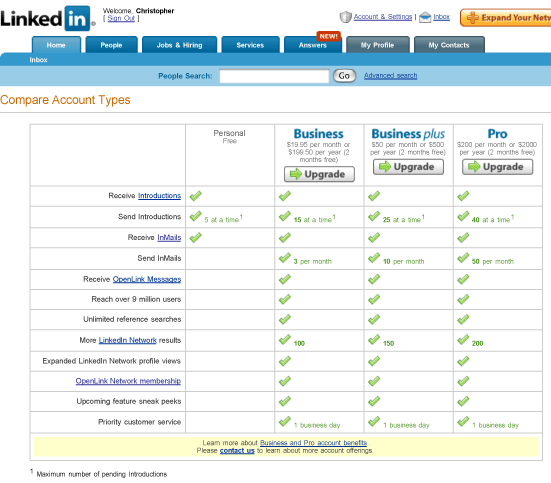
What a difference a year makes! When I wrote The “Unofficial” LinkedIn User’s Guide over a year ago, I had no idea what a stir it would make and how many people it would help—or that it would end up spawning a new business. In January 2008, I launched the Executive’s Guide to LinkedIn (EGLI) as a service offering of my consulting business, and today I advise executives on using LinkedIn to increase their security and effectiveness—as individuals and corporate leaders.
My work with companies on innovation with Web 2.0 and LinkedIn enables me to pioneer new approaches to business processes, and I continue to share many nuggets on the EGLI blog. In addition, I have left the “Unofficial” Guide up here as a public service for general education.
Also, I’d like to clarify that the “Unofficial” Guide does not refer to the EGLI business in any way because it predates it, even though the EGLI website and blog link here so that readers can use the “Unofficial” Guide to increase their awareness of LinkedIn’s potential and skill with using it. My thanks to an acquaintance who recently pointed out that it could appear that the “Unofficial” Guide was reviewing the EGLI offering (that I was reviewing myself! ,^).
If you find this guide useful, you can find updated information at the EGLI blog. I also invite you to leave comments and share stories here or there. Thank you.
My 2 cents about Online Business Networking
1st advice “Grow your network while you don’t need it”
read other advices on http://eric-mariacher.blogspot.com/2006/05/my-2-cents-about-online-business.html
My problem with LinkedIn, we should I say is people I’ve signed up don’t actually go out and do the same! For the paid version is far too much!
Thanks for writing.
We all face this, and I think the key is to think about building a critical mass with a few key people to start with. After all, L.I. resembles “offline” networking in many ways, and focusing on the few key people you want to invest in most is critical to getting results.. and making sure they feel the same. I often start with (“how can I help you”?) and explicitly asking their goals.. and letting them know the same for me. If we align, great. If not, keep the person in mind for a “primary contact” for later when alignment may present itself.
All the best- Chris
Hi Eric,
You’ve hit on a couple of key points, which I learned through networlding.com, which pictures you in the middle of 3 concentric circles. The liberating thing is when (as you point out in your excellent post) you picture different roles/goals for the different “styles” of networking.
Further, it’s a cliche that we’re increasingly in the “networked” world, which means more change. When people think “I need to network because I might need to change jobs,” they’re operating from an old world model in which there wasn’t much change. Also, bringing external knowledge into the job is more critical to success, so one’s network is key for that, too.
Thanks for writing!
Chris
[…] “Unofficial User’s Guide” is divided into two parts: The Basics and Advanced Techniques. If you are at the point of deciding whether LinkedIn could be useful to […]
[…] 1) The Unofficial LinkedIn User’s Guide for Executives and Professionals. This is so valuable insight. After reading these articles on Global Human Resources Capital Journal you know how to turn linkedin into a goldmine for yourself. […]
I recommend this page all Executives who wants to be Executives in the next few years still.
Web 2.0 and Global Financial Crisis will change the current EcoSystem and will result Trust Economy. Web 2.0 is the tool of this economy.
– Jozsef
[…] The Unofficial LinkedIn User’s Guide for Executives and Professionals Payment Processor Wins Web 0.2 Citation for Delivering “Yechsperience™” […]
[…] especially true for senior roles. Today, executives are expected to have an online presence – particularly on LinkedIn – which casts them as a thought leader, passionate about what they do and able to inspire […]
[…] To learn every single one of LinkedIn’s little-known features and understand the platform better than 99.9% of your colleagues ever will, read this excellent Unofficial LinkedIn User’s Guide For Executives & Professionals. […]